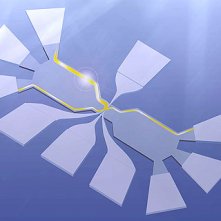Researchers come closer to weaving quantum “braids.”

A pair of new studies documents the existence of “quasiparticles” with one quarter the electric charge of a single electron—odd, considering that electrons can not actually be split into smaller particles. More than a mere curiosity, the demonstration may hold the key to a powerful form of quantum computing in which the quasiparticles’ quantum states could be braided together.
Fractional charges are nothing new. Researchers learned to make them more than 20 years ago by first confining electrons to a thin layer of semiconductor, chilling them to near absolute zero (–459.67 degrees Fahrenheit, or –273.15 degrees Celsius) and applying a magnetic field. They then introduced a voltage to initiate a current that flowed around the edges of the semiconductor sample, where it encountered resistance from the material.
Strangely, the resistance grew in steps that were too small to be explained by the motions of individual electrons. Researchers believe that the fractional quantum Hall effect, as it is known, occurs because electrons merge with portions of a magnetic field into collectives that flow like individual electrons. These discoveries garnered the 1998 Nobel Prize in Physics.
The fractional quantum Hall effect seemed destined to remain an abstruse playground until 2003, when researchers discovered that certain quasiparticles could lead to a highly stable topological quantum computer. Any kind of quantum computation derives its power from turning particles into quantum bits, which represent 0 and 1 simultaneously. In conventional approaches, researchers link quantum bits using wires or lasers, which risks exposing the bits to outside vibrations that would degrade their quantum character. In contrast, certain quasiparticles could connect simply by swapping locations, much like shuffling a deck of cards. The quasiparticles would “remember” the paths they took, no matter how intertwined, which (in theory) would make them more immune to noise.
“The ideas are beautiful, and they drive very beautiful science,” says experimental physicist Moty Heiblum of the Weizmann Institute of Science in Rehovot, Israel. Past examples of quasiparticles all had odd fractional charges, such as one third. For quantum computing, pairs of quasiparticles would have to join up and generate quarter charges. Inspired by the theoretical work, Heiblum’s group and a team from Harvard University and the Massachusetts Institute of Technology (MIT) separately set up fractional charge experiments as usual in a layer of aluminum gallium arsenide sandwiched between layers of gallium arsenide. But they tuned the middle layer to contain five electrons for every two magnetic field lines—the state predicted to generate quarter electron charges.
The Weizmann scientists measured random fluctuations in the current across a pinch in the plane, which allows only one charge-carrying particle through at a time. This “shot noise,” similar to the static in a radio signal, was consistent with quasiparticles carrying one quarter an electron charge, the group reports in Nature. The second team obtained similar results, published in Science, by measuring current directly.
Not all quarter-charge particles would work for topological quantum computation. In physics-speak, they must also obey something called non-Abelian (non-commutative) statistics, which hinges on the strength of the interaction between the paired quasiparticles. The method used by the Harvard–MIT experimenters allowed them to measure that strength. It was not conclusive, but “the favored models do indeed have non-Abelian statistics,” says Harvard physicist Charles Marcus.
The observation of the new quasiparticles is “quite neat and potentially seminal,” says theoretical physicist Sankar Das Sarma of the University of Maryland, College Park. The definitive test of non-Abelian statistics will come, he says, when researchers learn to isolate pairs of quasiparticles side by side and swap their positions. The Weizmann and Harvard–MIT groups are working on that, but it may take a couple of years. Heiblum predicts that of all the experiments he has done, “it will be one of the most difficult.”
